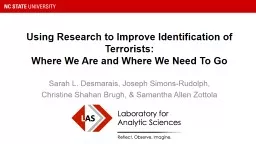PPT-Using Research to Improve Identification of Terrorists
Author : phoebe-click | Published Date : 2019-10-31
Using Research to Improve Identification of Terrorists Where We Are and W here We Need To Go Sarah L Desmarais Joseph SimonsRudolph Christine Shahan Brugh amp
Presentation Embed Code
Download Presentation
Download Presentation The PPT/PDF document "Using Research to Improve Identificat..." is the property of its rightful owner. Permission is granted to download and print the materials on this website for personal, non-commercial use only, and to display it on your personal computer provided you do not modify the materials and that you retain all copyright notices contained in the materials. By downloading content from our website, you accept the terms of this agreement.
Using Research to Improve Identification of Terrorists: Transcript
Download Rules Of Document
"Using Research to Improve Identification of Terrorists"The content belongs to its owner. You may download and print it for personal use, without modification, and keep all copyright notices. By downloading, you agree to these terms.
Related Documents














